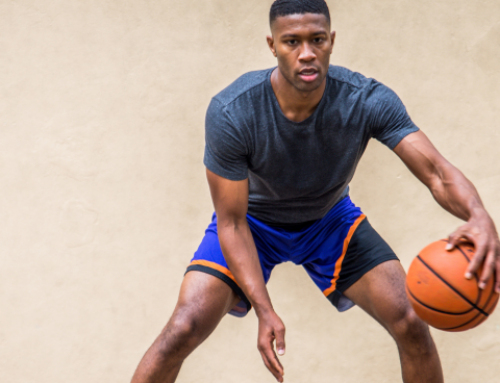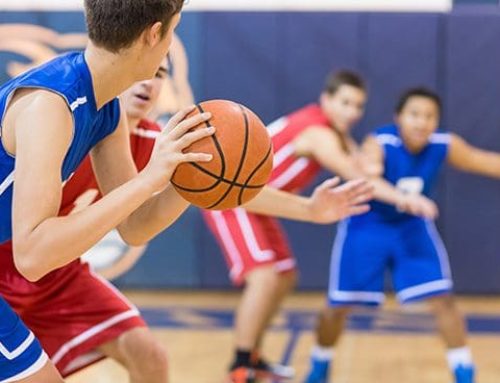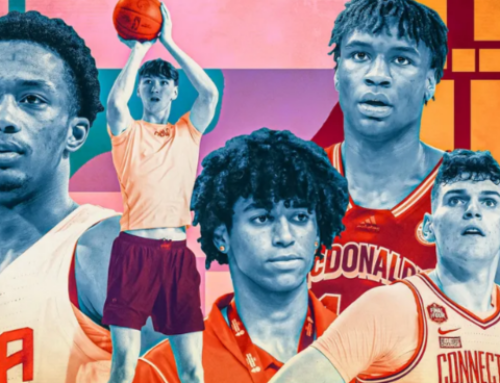Get in Shape With This Basketball Conditioning Workout
Basketball players need to be capable of both power and endurance. The sport consists of explosive movements over a long duration, usually in short bursts of activity. On average, an NCAA tournament game has anywhere from 30 seconds to 2 minutes of action with roughly 30- to 50-second breaks for fouls, turnovers, etc. (not counting media timeouts, quarter breaks and halftime.) \2 minutes 22 seconds – Work
- 40 seconds – Rest
- 42 seconds – Work
- 17 seconds – Rest
- 31 seconds – Work
- 35 seconds – Rest
Using similar timing intervals, the following basketball conditioning program mimics those metabolic demands while also developing the physical qualities needed for performance on the court.
Guidelines
Before attempting this workout, select exercises and resistance that allow you to maintain correct form. In addition, please note that this is a basketball conditioning workout, not muscular strength or hypertrophy training. Thus, the resistance and exercises should be appropriate for conditioning. Fatigue is a serious factor in this workout, just like it is in a game, so maintaining correct execution is vital to success.
The workout is divided into four quarters, each with a different focus. The quarters are timed based on actual game-play intervals. Our recommendation is that you watch tape of your old games and use them as sample intervals. We use a variety of intervals based on various game films we have watched.
The workout is preceded by self-myofascial release and followed by a cool-down and proper recovery. We have included one sample quarter at the end for you to try.
First Quarter: Dynamic Warm-Ups
Dynamic warm-ups are an integral part of our program and help prepare our athletes for a successful game or workout. When designing warm-ups, we include calisthenics to increase heart rate and core temperature, movement prep drills to reinforce technique, and muscle activation exercises to prepare muscles for work. For this program, we generally pick three to four exercises that accomplish those goals and work them into our intervals. In addition, we try to use basketballs as much as possible.
Here is an example of a warm-up we use:
- Forward Lunge and Rip Across with Basketball
- Reverse Lunge and Overhead Reach with Basketball
- Single-Leg RDL (Romanian Deadlift) with Forward Reach with Basketball
Second Quarter: Speed, Agility, and Power
We use the second quarter of the workout to practice explosive movements at game speed. We do not use heavy weights or resistance. With lighter resistance, we emphasize form and speed of movement. In addition, we usually pair an upper-body or core-focused activity with a lower-body exercise. Here are a couple of examples of circuits we use:
- Medicine Ball Chops paired with Single-Leg Lateral Hops
- Medicine Ball Windmills paired with Defensive Slides
- Medicine Ball Slams paired with Squat Jumps
- Medicine Ball Pump Fakes with 10-yard Sprints to Backpedals
Third Quarter: Strength and Stability
In the third quarter, we emphasize execution when fatigued, especially balance and body control. The focus is on time under tension and proprioception, along with exercises to stabilize potential weak links. We often perform this quarter without shoes to improve balance and strength around the ankles. We generally try to pair lower-body balance exercises with core and/or shoulder-stability exercises. Some of our favorites include:
- Clock Lunges with Push-Up Rows
- Single-Leg Box Squats with Farmer’s Walks
- Single-Leg RDLs with Anti-Rotation Presses
Fourth Quarter: Low Impact Metabolic Conditioning, Teamwork
The final quarter of our basketball conditioning workout centers on teamwork and overcoming adversity. We incorporate partner drills and low-impact conditioning drills. We avoid explosive or high-impact exercises like jumps and sprints, and we emphasize low-impact exercises to minimize the risk of injury. Below are a couple of our favorite metabolic and team-building drills:
- Plate Push Relays
- Partner Farmer’s Walks
- Box Out Circle Drill
- Dumbbell and Barbell Complexes
- Battle Rope Circuits
- Medicine Ball Complexes
One Full Quarter
To give you an idea of how a full quarter looks, we include a sample warm-up quarter below.
Warm-Up Exercises
- Forward Lunge and Rip Across with Basketball
- Reverse Lunge and Overhead Reach with Basketball
- Single-Leg RDL with Forward Reach with Basketball
Timed Interval Breakdown: (Based on actual game play)
- 44 seconds – Forward Lunge and Rip Across with Basketball
- 15 seconds – Rest
- 45 seconds – Reverse Lunge and Overhead Reach with Basketball
- 20 seconds – Rest
- 1 minute 43 seconds – Single-Leg RDL with Forward Reach with Basketball
- 20 seconds – Rest
- 12 seconds – Forward Lunge and Rip Across with Basketball
- 42 seconds – Rest
- 1 minute 35 seconds – Reverse Lunge and Overhead Reach with Basketball
- 20 seconds – Rest
- 1 minute 22 seconds – Single-Leg RDL with Forward Reach with Basketball
- 54 seconds – Rest
- 32 seconds – Forward Lunge and Rip Across with Basketball
End of first quarter
RELATED: Basketball Conditioning Workout for Fourth Quarter Energy
RECOMMENDED FOR YOU
MOST POPULAR
Get in Shape With This Basketball Conditioning Workout
Basketball players need to be capable of both power and endurance. The sport consists of explosive movements over a long duration, usually in short bursts of activity. On average, an NCAA tournament game has anywhere from 30 seconds to 2 minutes of action with roughly 30- to 50-second breaks for fouls, turnovers, etc. (not counting media timeouts, quarter breaks and halftime.) \2 minutes 22 seconds – Work
- 40 seconds – Rest
- 42 seconds – Work
- 17 seconds – Rest
- 31 seconds – Work
- 35 seconds – Rest
Using similar timing intervals, the following basketball conditioning program mimics those metabolic demands while also developing the physical qualities needed for performance on the court.
Guidelines
Before attempting this workout, select exercises and resistance that allow you to maintain correct form. In addition, please note that this is a basketball conditioning workout, not muscular strength or hypertrophy training. Thus, the resistance and exercises should be appropriate for conditioning. Fatigue is a serious factor in this workout, just like it is in a game, so maintaining correct execution is vital to success.
The workout is divided into four quarters, each with a different focus. The quarters are timed based on actual game-play intervals. Our recommendation is that you watch tape of your old games and use them as sample intervals. We use a variety of intervals based on various game films we have watched.
The workout is preceded by self-myofascial release and followed by a cool-down and proper recovery. We have included one sample quarter at the end for you to try.
First Quarter: Dynamic Warm-Ups
Dynamic warm-ups are an integral part of our program and help prepare our athletes for a successful game or workout. When designing warm-ups, we include calisthenics to increase heart rate and core temperature, movement prep drills to reinforce technique, and muscle activation exercises to prepare muscles for work. For this program, we generally pick three to four exercises that accomplish those goals and work them into our intervals. In addition, we try to use basketballs as much as possible.
Here is an example of a warm-up we use:
- Forward Lunge and Rip Across with Basketball
- Reverse Lunge and Overhead Reach with Basketball
- Single-Leg RDL (Romanian Deadlift) with Forward Reach with Basketball
Second Quarter: Speed, Agility, and Power
We use the second quarter of the workout to practice explosive movements at game speed. We do not use heavy weights or resistance. With lighter resistance, we emphasize form and speed of movement. In addition, we usually pair an upper-body or core-focused activity with a lower-body exercise. Here are a couple of examples of circuits we use:
- Medicine Ball Chops paired with Single-Leg Lateral Hops
- Medicine Ball Windmills paired with Defensive Slides
- Medicine Ball Slams paired with Squat Jumps
- Medicine Ball Pump Fakes with 10-yard Sprints to Backpedals
Third Quarter: Strength and Stability
In the third quarter, we emphasize execution when fatigued, especially balance and body control. The focus is on time under tension and proprioception, along with exercises to stabilize potential weak links. We often perform this quarter without shoes to improve balance and strength around the ankles. We generally try to pair lower-body balance exercises with core and/or shoulder-stability exercises. Some of our favorites include:
- Clock Lunges with Push-Up Rows
- Single-Leg Box Squats with Farmer’s Walks
- Single-Leg RDLs with Anti-Rotation Presses
Fourth Quarter: Low Impact Metabolic Conditioning, Teamwork
The final quarter of our basketball conditioning workout centers on teamwork and overcoming adversity. We incorporate partner drills and low-impact conditioning drills. We avoid explosive or high-impact exercises like jumps and sprints, and we emphasize low-impact exercises to minimize the risk of injury. Below are a couple of our favorite metabolic and team-building drills:
- Plate Push Relays
- Partner Farmer’s Walks
- Box Out Circle Drill
- Dumbbell and Barbell Complexes
- Battle Rope Circuits
- Medicine Ball Complexes
One Full Quarter
To give you an idea of how a full quarter looks, we include a sample warm-up quarter below.
Warm-Up Exercises
- Forward Lunge and Rip Across with Basketball
- Reverse Lunge and Overhead Reach with Basketball
- Single-Leg RDL with Forward Reach with Basketball
Timed Interval Breakdown: (Based on actual game play)
- 44 seconds – Forward Lunge and Rip Across with Basketball
- 15 seconds – Rest
- 45 seconds – Reverse Lunge and Overhead Reach with Basketball
- 20 seconds – Rest
- 1 minute 43 seconds – Single-Leg RDL with Forward Reach with Basketball
- 20 seconds – Rest
- 12 seconds – Forward Lunge and Rip Across with Basketball
- 42 seconds – Rest
- 1 minute 35 seconds – Reverse Lunge and Overhead Reach with Basketball
- 20 seconds – Rest
- 1 minute 22 seconds – Single-Leg RDL with Forward Reach with Basketball
- 54 seconds – Rest
- 32 seconds – Forward Lunge and Rip Across with Basketball
End of first quarter
RELATED: Basketball Conditioning Workout for Fourth Quarter Energy










